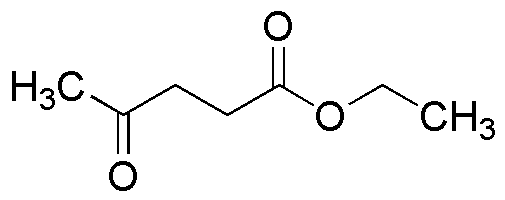Ethyl levulinate is widely utilized in research focused on:
- Biofuel Production: This compound serves as a promising biofuel additive, enhancing the combustion properties of traditional fuels and contributing to cleaner energy solutions.
- Flavoring and Fragrance Industry: Ethyl levulinate is used as a flavoring agent in food products and beverages, providing a sweet, fruity aroma that enhances consumer appeal.
- Solvent Applications: It acts as an effective solvent in various chemical reactions and processes, particularly in the extraction of natural products, making it valuable in pharmaceuticals and cosmetics.
- Polymer Synthesis: This compound is utilized in the production of biodegradable polymers, which are increasingly important in reducing plastic waste and promoting sustainability.
- Research in Organic Chemistry: Ethyl levulinate is a key intermediate in organic synthesis, allowing researchers to develop new compounds and materials with diverse applications.
General Information
Properties
Safety and Regulations
Applications
Ethyl levulinate is widely utilized in research focused on:
- Biofuel Production: This compound serves as a promising biofuel additive, enhancing the combustion properties of traditional fuels and contributing to cleaner energy solutions.
- Flavoring and Fragrance Industry: Ethyl levulinate is used as a flavoring agent in food products and beverages, providing a sweet, fruity aroma that enhances consumer appeal.
- Solvent Applications: It acts as an effective solvent in various chemical reactions and processes, particularly in the extraction of natural products, making it valuable in pharmaceuticals and cosmetics.
- Polymer Synthesis: This compound is utilized in the production of biodegradable polymers, which are increasingly important in reducing plastic waste and promoting sustainability.
- Research in Organic Chemistry: Ethyl levulinate is a key intermediate in organic synthesis, allowing researchers to develop new compounds and materials with diverse applications.
Documents
Safety Data Sheets (SDS)
The SDS provides comprehensive safety information on handling, storage, and disposal of the product.
Product Specification (PS)
The PS provides a comprehensive breakdown of the product’s properties, including chemical composition, physical state, purity, and storage requirements. It also details acceptable quality ranges and the product's intended applications.
Certificates of Analysis (COA)
Search for Certificates of Analysis (COA) by entering the products Lot Number. Lot and Batch Numbers can be found on a product’s label following the words ‘Lot’ or ‘Batch’.
*Catalog Number
*Lot Number
Certificates Of Origin (COO)
This COO confirms the country where the product was manufactured, and also details the materials and components used in it and whether it is derived from natural, synthetic, or other specific sources. This certificate may be required for customs, trade, and regulatory compliance.
*Catalog Number
*Lot Number
Safety Data Sheets (SDS)
The SDS provides comprehensive safety information on handling, storage, and disposal of the product.
DownloadProduct Specification (PS)
The PS provides a comprehensive breakdown of the product’s properties, including chemical composition, physical state, purity, and storage requirements. It also details acceptable quality ranges and the product's intended applications.
DownloadCertificates of Analysis (COA)
Search for Certificates of Analysis (COA) by entering the products Lot Number. Lot and Batch Numbers can be found on a product’s label following the words ‘Lot’ or ‘Batch’.
*Catalog Number
*Lot Number
Certificates Of Origin (COO)
This COO confirms the country where the product was manufactured, and also details the materials and components used in it and whether it is derived from natural, synthetic, or other specific sources. This certificate may be required for customs, trade, and regulatory compliance.

